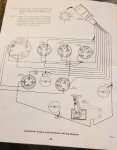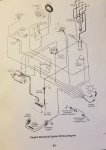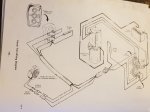floppybear
Cadet
- Joined
- Oct 30, 2019
- Messages
- 12
It's my first post here...seems like a great community with lots of helpful info! I have been working on a 1986 19' Sea Ray Seville II Cuddy Cabin I recently picked up with a Mercruiser 170 and Alpha One Gen 1 outdrive, and closed cooling. I have done lots of work and all the routine maintenance, changed ignition to electronic, swapped starter, impeller, fluids, filters, plenty of 2-4-C involved, drained raw water out before winter, etc. The boat has been garage kept and seldom used its entire life, very well taken care of with the original manuals and lots of service receipts included. I had it running very well and was actually about to do my first water test (I know, I know, never buy a boat without a water test but it's in great condition and I saw it running well and for the price, if it floats it was a great deal).
Anyway, I decided to start the boat up on muffs at home to test my lower shift cable alignment before heading to the lake today. That's the first issue I have, the brass barrel on the lower shift cable will not budge and I don't want to force it and break something. Does anyone have a suggestion for that? It's a little bit rough going into reverse and shudders just a bit going into forward currently after putting the outdrive back on the boat.
On to the main story: I didn't realize at first what occurred today, but first I'll tell you what I witnessed. I attached the hose to the muffs and got in the boat to trim the motor up slightly so as not to have the prop hitting the gravel once the motor was started. I then hopped out of the boat and went over to the hose connection to turn the water on. I thought it was curious I heard what sounded like a pump in the bilge/transom area running when I walked towards the house to turn water on. No switches were on and no water was in the bilge (float switch works fine and manual switch for pump was off so I thought it was odd/interesting to hear a pump running as I walked away from the boat).
I then got back on the boat, put the key in the ignition, and attempted to start it up. All I got was a click from the solenoid (starter was working perfectly yesterday and nothing had changed) and then, the magic smoke. Emanating heavily from under the dashboard, seemingly centralized to the tachometer area, was wiring starting to become hot enough to melt, and white smoke pouring out. Of course, I immediately turned the key off and removed it from the ignition, but the smoke seemed to continue to intensify. I made a beeline for the battery and immediately disconnected the negative terminal. The smoke lessened, then stopped, and I began to try to diagnose what the heck happened to cause this almost catastrophic electrical fault.
After a bit of investigation, it appeared as though the black ground wire connected to the tachometer as well as the other instruments in the dash panel then going through the main wiring harness to the stern had decided to shed/melt its cable jacket in a dramatic fashion. I ended up pulling the whole wire harness out from its zip tie supports to check what damage was done. It seems as though I caught it in time to A. prevent a large fire and B. seemingly prevent damage to most or all other wires in the harness. Pretty much all that got hot enough to melt was the black ground wire and the melting only barely made its way into the harness where all the wires join together to run aft.
I followed the wires aft and also consulted the diagrams in the boat manual (which I have included here). I found that nothing really melted except that one black ground wire across the instruments and just barely into the harness. Damage to other cables seems very limited and the worst I found is part of the black ground cable's jacket melted onto the jacket of one or two other wires in a couple of places, but no significant damage to those other wires themselves. I plan to continuity test as much as I can with a meter from one end of the harness to the other.
After I took a better look in the transom area, I figured out what caused this whole thing. Going back to when I slightly trimmed the motor up before attempting to start it up, I found that a black cable with 2 conductors had come loose and was pinched inside when I trimmed the outdrive up. One end of this cable goes to the 50 amp breaker on the motor, with both conductors connected to the breaker. I noticed that the screw on one of the breaker terminals was a bit, uhhh "browned". The other end of this cable I believe goes to the power trim pump area, where it splits off to a blue white and a purple white wire, and those are also hooked into to the main wire harness.
So, what I think happened to cause the fault is when I trimmed the drive up, this wire got pinched and caused an electrical short causing a pump to run continuously (I may have burned out the pump as I don't think it was still running when I got back to the boat but I may be remembering this incorrectly because the smoke was a more immediate concern and more memorable at the time until I disconnected the battery). I then tried to start the motor, and voltage went where it shouldn't have, because somehow the tachometer became the most efficient path for this short to try to ground out. This thin wire clearly couldn't handle the excessive current and began to melt. When I removed the key, the smoke continued, so the fault theoretically had to involve something that gets power with no ignition or switches turned on, just 12v direct from the battery. This includes the radio, the bilge pump, and the outdrive trim.
So anyway, I know what happened at least, and I still have a boat that I can probably repair. I'm somewhat skilled with wiring and comfortable with most aspects of especially DC low voltage wiring (and I know that current in DC circuits can easily be enough to cause a fire, especially after today). I'm wondering if any of you fine folks would be willing to take a look at the wiring diagrams and try to help me determine what needs to be replaced to make my boat electrically safe again.
Of course, at a minimum anything that is melted needs to be completely replaced. It wouldn't be too big of an issue to run a new ground wire from the battery up to the dashboard area. However, I'm concerned about potential damage I can't see in the other wires in the harness (they appear totally fine with one or two spots where the black wire was touching but didn't damage the jacket of other wires). If I test impedance and continuity of the other wires in the harness, would that be a sufficient method to ensure that those other wires are still functional and safe?
The other thing I'm concerned about is the 50 amp breaker. It obviously didn't function as intended, but that's almost definitely because I crushed/shorted two of the wires connected to it. That screw got hot enough to turn brown, but nothing is melted and that appears to be the only visible damage. Would it be wise to replace the whole breaker? I can easily replace the wires that were crushed and the replace the melted black ground wire in the harness with a new one, but I want to make sure I'm not missing anything that could be important before hooking this all back up and having something go wrong.
In the meantime, I've ordered a 50 amp breaker to wire directly to the battery terminal to act as a main breaker to prevent a catastrophic fault like this from happening again. However, that would prevent the bilge pump float switch from operating if the breaker is tripped. Shouldn't be an issue as I trailer my boat and I would know the breaker isn't tripped if I'm on the boat using it, but maybe I should just wire just the bilge pump direct to the battery and everything else through the breaker?
Anyways, please help me determine what needs to be checked out and done here! Sorry for the long post. And thanks in advance for any advice.
Anyway, I decided to start the boat up on muffs at home to test my lower shift cable alignment before heading to the lake today. That's the first issue I have, the brass barrel on the lower shift cable will not budge and I don't want to force it and break something. Does anyone have a suggestion for that? It's a little bit rough going into reverse and shudders just a bit going into forward currently after putting the outdrive back on the boat.
On to the main story: I didn't realize at first what occurred today, but first I'll tell you what I witnessed. I attached the hose to the muffs and got in the boat to trim the motor up slightly so as not to have the prop hitting the gravel once the motor was started. I then hopped out of the boat and went over to the hose connection to turn the water on. I thought it was curious I heard what sounded like a pump in the bilge/transom area running when I walked towards the house to turn water on. No switches were on and no water was in the bilge (float switch works fine and manual switch for pump was off so I thought it was odd/interesting to hear a pump running as I walked away from the boat).
I then got back on the boat, put the key in the ignition, and attempted to start it up. All I got was a click from the solenoid (starter was working perfectly yesterday and nothing had changed) and then, the magic smoke. Emanating heavily from under the dashboard, seemingly centralized to the tachometer area, was wiring starting to become hot enough to melt, and white smoke pouring out. Of course, I immediately turned the key off and removed it from the ignition, but the smoke seemed to continue to intensify. I made a beeline for the battery and immediately disconnected the negative terminal. The smoke lessened, then stopped, and I began to try to diagnose what the heck happened to cause this almost catastrophic electrical fault.
After a bit of investigation, it appeared as though the black ground wire connected to the tachometer as well as the other instruments in the dash panel then going through the main wiring harness to the stern had decided to shed/melt its cable jacket in a dramatic fashion. I ended up pulling the whole wire harness out from its zip tie supports to check what damage was done. It seems as though I caught it in time to A. prevent a large fire and B. seemingly prevent damage to most or all other wires in the harness. Pretty much all that got hot enough to melt was the black ground wire and the melting only barely made its way into the harness where all the wires join together to run aft.
I followed the wires aft and also consulted the diagrams in the boat manual (which I have included here). I found that nothing really melted except that one black ground wire across the instruments and just barely into the harness. Damage to other cables seems very limited and the worst I found is part of the black ground cable's jacket melted onto the jacket of one or two other wires in a couple of places, but no significant damage to those other wires themselves. I plan to continuity test as much as I can with a meter from one end of the harness to the other.
After I took a better look in the transom area, I figured out what caused this whole thing. Going back to when I slightly trimmed the motor up before attempting to start it up, I found that a black cable with 2 conductors had come loose and was pinched inside when I trimmed the outdrive up. One end of this cable goes to the 50 amp breaker on the motor, with both conductors connected to the breaker. I noticed that the screw on one of the breaker terminals was a bit, uhhh "browned". The other end of this cable I believe goes to the power trim pump area, where it splits off to a blue white and a purple white wire, and those are also hooked into to the main wire harness.
So, what I think happened to cause the fault is when I trimmed the drive up, this wire got pinched and caused an electrical short causing a pump to run continuously (I may have burned out the pump as I don't think it was still running when I got back to the boat but I may be remembering this incorrectly because the smoke was a more immediate concern and more memorable at the time until I disconnected the battery). I then tried to start the motor, and voltage went where it shouldn't have, because somehow the tachometer became the most efficient path for this short to try to ground out. This thin wire clearly couldn't handle the excessive current and began to melt. When I removed the key, the smoke continued, so the fault theoretically had to involve something that gets power with no ignition or switches turned on, just 12v direct from the battery. This includes the radio, the bilge pump, and the outdrive trim.
So anyway, I know what happened at least, and I still have a boat that I can probably repair. I'm somewhat skilled with wiring and comfortable with most aspects of especially DC low voltage wiring (and I know that current in DC circuits can easily be enough to cause a fire, especially after today). I'm wondering if any of you fine folks would be willing to take a look at the wiring diagrams and try to help me determine what needs to be replaced to make my boat electrically safe again.
Of course, at a minimum anything that is melted needs to be completely replaced. It wouldn't be too big of an issue to run a new ground wire from the battery up to the dashboard area. However, I'm concerned about potential damage I can't see in the other wires in the harness (they appear totally fine with one or two spots where the black wire was touching but didn't damage the jacket of other wires). If I test impedance and continuity of the other wires in the harness, would that be a sufficient method to ensure that those other wires are still functional and safe?
The other thing I'm concerned about is the 50 amp breaker. It obviously didn't function as intended, but that's almost definitely because I crushed/shorted two of the wires connected to it. That screw got hot enough to turn brown, but nothing is melted and that appears to be the only visible damage. Would it be wise to replace the whole breaker? I can easily replace the wires that were crushed and the replace the melted black ground wire in the harness with a new one, but I want to make sure I'm not missing anything that could be important before hooking this all back up and having something go wrong.
In the meantime, I've ordered a 50 amp breaker to wire directly to the battery terminal to act as a main breaker to prevent a catastrophic fault like this from happening again. However, that would prevent the bilge pump float switch from operating if the breaker is tripped. Shouldn't be an issue as I trailer my boat and I would know the breaker isn't tripped if I'm on the boat using it, but maybe I should just wire just the bilge pump direct to the battery and everything else through the breaker?
Anyways, please help me determine what needs to be checked out and done here! Sorry for the long post. And thanks in advance for any advice.

























